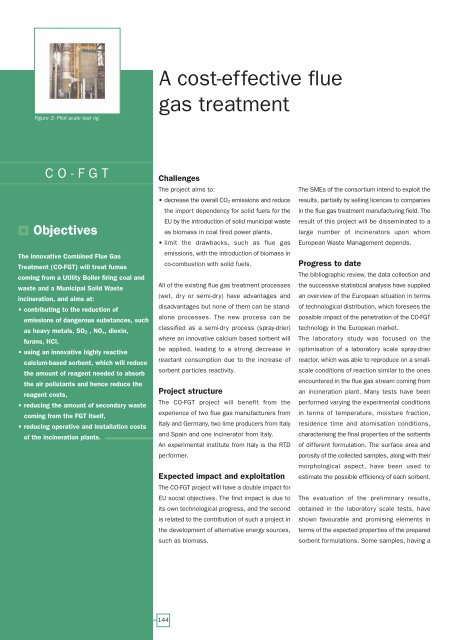European Bio-Energy Projects
European Bio-Energy Projects
European Bio-Energy Projects
Create successful ePaper yourself
Turn your PDF publications into a flip-book with our unique Google optimized e-Paper software.
Figure 3: Pilot scale test rig.<br />
CO-FGT<br />
Objectives<br />
The innovative Combined Flue Gas<br />
Treatment (CO-FGT) will treat fumes<br />
coming from a Utility Boiler firing coal and<br />
waste and a Municipal Solid Waste<br />
incineration, and aims at:<br />
• contributing to the reduction of<br />
emissions of dangerous substances, such<br />
as heavy metals, SO2 , NOx, dioxin,<br />
furans, HCl,<br />
• using an innovative highly reactive<br />
calcium-based sorbent, which will reduce<br />
the amount of reagent needed to absorb<br />
the air pollutants and hence reduce the<br />
reagent costs,<br />
• reducing the amount of secondary waste<br />
coming from the FGT itself,<br />
• reducing operative and installation costs<br />
of the incineration plants.<br />
A cost-effective flue<br />
gas treatment<br />
Challenges<br />
The project aims to:<br />
• decrease the overall CO2 emissions and reduce<br />
the import dependency for solid fuels for the<br />
EU by the introduction of solid municipal waste<br />
as biomass in coal fired power plants,<br />
• limit the drawbacks, such as flue gas<br />
emissions, with the introduction of biomass in<br />
co-combustion with solid fuels.<br />
All of the existing flue gas treatment processes<br />
(wet, dry or semi-dry) have advantages and<br />
disadvantages but none of them can be standalone<br />
processes. The new process can be<br />
classified as a semi-dry process (spray-drier)<br />
where an innovative calcium based sorbent will<br />
be applied, leading to a strong decrease in<br />
reactant consumption due to the increase of<br />
sorbent particles reactivity.<br />
Project structure<br />
The CO-FGT project will benefit from the<br />
experience of two flue gas manufacturers from<br />
Italy and Germany, two lime producers from Italy<br />
and Spain and one incinerator from Italy.<br />
An experimental institute from Italy is the RTD<br />
performer.<br />
Expected impact and exploitation<br />
The CO-FGT project will have a double impact for<br />
EU social objectives. The first impact is due to<br />
its own technological progress, and the second<br />
is related to the contribution of such a project in<br />
the development of alternative energy sources,<br />
such as biomass.<br />
144<br />
The SMEs of the consortium intend to exploit the<br />
results, partially by selling licences to companies<br />
in the flue gas treatment manufacturing field. The<br />
result of this project will be disseminated to a<br />
large number of incinerators upon whom<br />
<strong>European</strong> Waste Management depends.<br />
Progress to date<br />
The bibliographic review, the data collection and<br />
the successive statistical analysis have supplied<br />
an overview of the <strong>European</strong> situation in terms<br />
of technological distribution, which foresees the<br />
possible impact of the penetration of the CO-FGT<br />
technology in the <strong>European</strong> market.<br />
The laboratory study was focused on the<br />
optimisation of a laboratory scale spray-drier<br />
reactor, which was able to reproduce on a smallscale<br />
conditions of reaction similar to the ones<br />
encountered in the flue gas stream coming from<br />
an incineration plant. Many tests have been<br />
performed varying the experimental conditions<br />
in terms of temperature, moisture fraction,<br />
residence time and atomisation conditions,<br />
characterising the final properties of the sorbents<br />
of different formulation. The surface area and<br />
porosity of the collected samples, along with their<br />
morphological aspect, have been used to<br />
estimate the possible efficiency of each sorbent.<br />
The evaluation of the preliminary results,<br />
obtained in the laboratory scale tests, have<br />
shown favourable and promising elements in<br />
terms of the expected properties of the prepared<br />
sorbent formulations. Some samples, having a

















